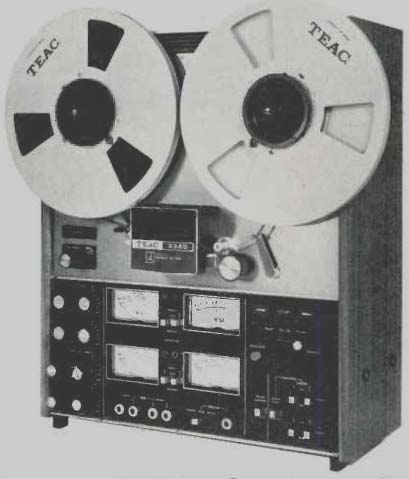
MANUFACTURERS SPECIFICATIONS
Tape speed: 7 1/2 and 15 ips.
Reel Size: 10 and 7 inches.
Motors: 1 dual-speed hysteresis synchronous, 2 eddy current capstan.
Heads: 3 four-track and two channel.
Wow and flutter: 0.04% at 15 ips, 0.06% at 7 1/2 ips.
Frequency response: 30 to 20,000 Hz ±3 dB at 15 ips, 30 to 18,000 Hz ±3 dB at 7 1/2 ips.
Signal to noise: 60 dB. THD: 1% at 0 VU.
Crosstalk: 60 dB at 1000 Hz.
Inputs: Mic: 0.25 mV, Line 0.1 mV at 50,000 ohms or higher.
Outputs: 0.3 v at 10,000 ohms.
Headphones: 8 ohms.
Dimensions: 20 1/2 by 17 1/4 by 8.
Price: $849.
The TEAC 3340 is primarily a quadraphonic recorder, a semiprofessional machine with a high standard of performance. However, it can be used for 2-channel record-playback, 1/2-track playback, mono record-playback as well as 4-channel record playback. The main feature of the 3340 is probably the SimulSync facility--about which more later.
Looking at the photograph, it will be seen that there is a group of eight controls on the left side. These are the output level controls and dual-concentric input controls for microphone and line. Above these is the tape speed knob with slide switch for small or large tape reels. The Simul-Sync unit is in the center and tape source-tape monitor switches are located between the VU meters. Underneath are the four microphone input jacks and a headphone socket. A slide switch allows the phones to be connected to the front or rear channels or F + R. At the right is the stop control, tape direction lever, record push-button, on/off switch, bias switch and record mode switches. The input and output sockets, plus a fuse and a power input socket are all located at the rear.
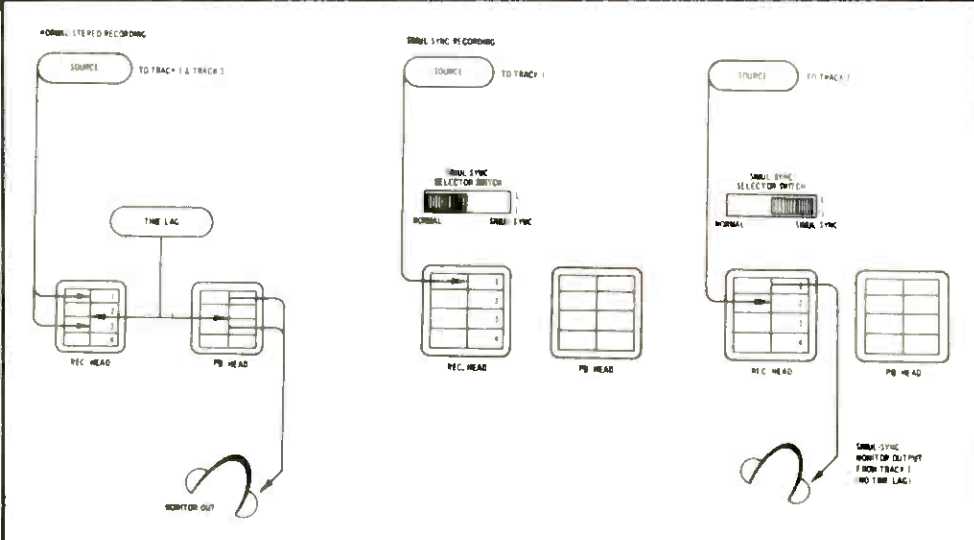
Fig. 1-Simul-Sync recording.
Simul-Sync Recording
This is a technique which allows you to play back and monitor one track without time delay while recording a second, third or fourth track in perfect synchronization. The head function switch provides this feature by changing the record head to playback when the switch is in the Simul-Sync position, thereby eliminating the time delay which is inevitable with conventional monitoring systems. See figure I. Thus, a rhythm section could be recorded on track 1, brass on track 2, piano on 3. A vocalist can then dub in later and the complete sound mix can be created by the independent level controls.
Figure 2 shows the view underneath. The main motor is a dual-speed hysteresis type and the reel motors are eddy current induction types. Figure 3 shows the heads and capstan assembly. Note the heavy, rigid base plate which is necessary to maintain correct alignment. Permalloy shielding is employed and then a hyperbolic shape is used which TEAC claim gives minimum head contact for reduced tape wear and increased head life. Other features of the 3340 include independent record and relay amplifiers, expanded scale VU meters, oil damped tension arm, "Quick Lok" reel holders, automatic tape lifters and provision for manual cueing.
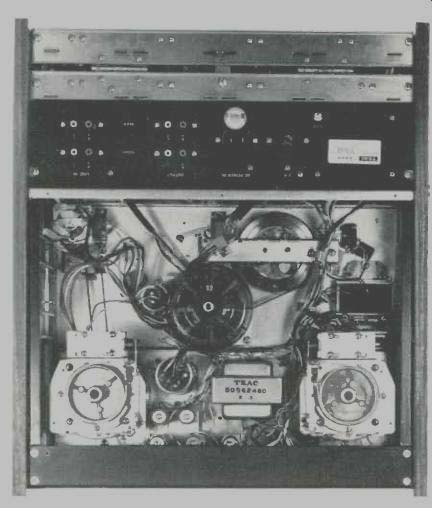
Fig. 2--Showing the view underneath
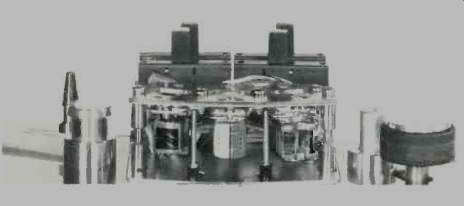
Fig. 3--Heads and capstan assembly
Measurement
The frequency response at 7 1/2 and 15 ips is shown in figure 4 and it will be seen that the upper 3 dB roll-offs are 26 kHz and 35 kHz with Maxell low-noise tape. Signal/noise was 60 dB (at 0 VU) at 7 1/2 ips and 63 dB at 15 ips. Distortion at l kHz, 0 VU measured 0.55%--better than the modest claim of 1%. Wow and flutter was 0.03% at 15 ips and 0.05% at 7 1/2 ips.
Input for 0 VU was 30 mV for line and 0.20 for mic. Maximum output at the line terminals was 1.2v at 0 VU. Fast winding time was 90 seconds for 1200 ft. and 120 seconds for 1800 ft.

Fig. 4--Record/replay response using Maxell low-noise tape and playback response
with standard tapes.
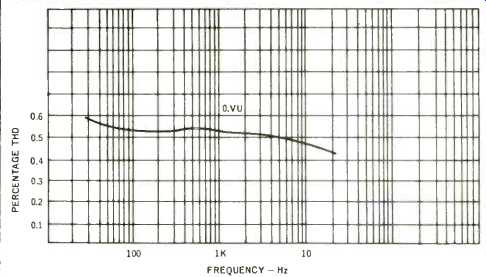
Fig. 5--THD vs frequency
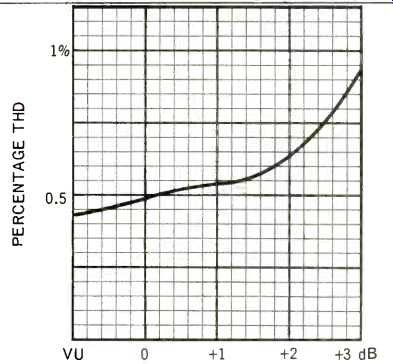
Fig. 6--THD at 1khz
Listening Tests
The 3340 was on test for a period of just over a month and gave every satisfaction. The controls were exceptionally easy to operate--in particular the stop button was absolutely positive, yet I never succeeded in breaking any tape not even 1 mil! Some 4-channel recordings were made using EV-RE 55 microphones and it was just possible to detect a difference between 15 ips and 71/2 ips but it was very slight. The Simul-Sync facility worked beautifully and so did the monitor switches. These perform three functions, they allow you to monitor either the source signal before it is recorded, or the signal from the tape and in addition they select the signal to be displayed on the VU meters and routed to the headphone jack. This recorder is particularly suitable for the semi-professional user, small rock groups or studio use but it is also recommended to any enthusiast who requires a 4-channel machine with top performance. At $849 it is not cheap but in our opinion, well worth the money.
-T.A.
=================
(Adapted from Audio magazine, Mar. 1973)
Also see:
TEAC A-1200U Stereo Tape Deck (Oct. 1970)
Wollensak Model 6364 Two/Four Channel Tape Recorder (Equip. Profile, Feb. 1972)
Telex-Viking Quad/Sonic 2 + 2 quadraphonic tape deck (Equip. Profile, Jan. 1972)
Teac X-20R Open-Reel Recorder (Equip. Profile, Mar. 1982)
TEAC Model C-1 Cassette Deck (Dec. 1979)
Technics SV-P100 Digital Audio Cassette Recorder (Apr. 1982)
Technics Model RS-616 Cassette Deck (Feb. 1979)
= = = =